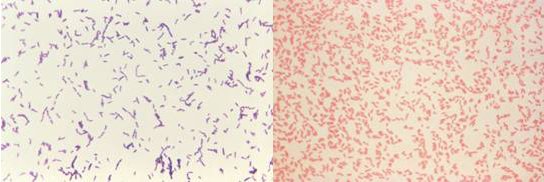Daily Archives: 21 October, 2019
This morning I went to a lecture held by Swedish Ministry of Health and Social Affairs. It was on actions how to prevent further development of antibiotic resistance. Antibiotics are medicines used to prevent and treat bacterial infections. Antibiotic resistance occurs when bacteria change in response to the use of these medicines. Bacteria, not humans or animals, become antibiotic-resistant. The antibiotics become less effective.
Most bacterias are classified into two different groups – Gram-positive (purple) or Gram-negative (pinkish or red) – depending on a specific stain color which can be seen in a microscope. The Gram stain test was developed in the 1800s by the Danish bacterologist Hans Christian Gram.
The image on the left shows Gram-positive bacteria. The image on the right is Gram-negative bacteria (Credit Centers for Disease Control and Prevention).

Examples of Gram-negative bacteria that have demonstrated drug resistance include:
- E. coli, which causes the majority of urinary tract infections
- Acinetobacter baumanii, which causes disease mainly in healthcare settings. In addition, wound infections caused by Acinetobacter have been found in U.S. military personnel who were deployed to Iraq and Afghanistan.
- Pseudomonas aeruginosa, which causes bloodstream infections and pneumonia in hospitalized patients. It is a common cause of pneumonia in patients with cystic fibrosis.
- Klebsiella pneumoniae, which causes many types of healthcare-associated infections, including pneumonia, urinary tract infections, and bloodstream infections
- Neisseria gonorrhoeae, which causes the sexually transmitted disease gonorrhea
This means that people may die, even though there is antibiotics available. Therefore, antibiotics should be used with caution. It should also be noted that people die due to no access at all to antibiotics. It is indeed a complex subject. The work against development of antibiotic resistance is also at a political level. Governmental action is taken, and bilateral collaborations are supported among various countries. The UN is also involved.
The WHO has many suggestions how to work on prevention. What can we do?
- Prevent infections by regularly washing hands
- Prepare food hygienically following WHO:
1) keep clean
2) separate raw and cooked
3) cook thoroughly
4) keep food at safe temperatures
5) use safe water and raw materials
- Choose food produced without the use of antibiotics for growth promotion
- Never share or use leftover antibiotics
- Always follow your health worker’s advice when using antibiotics
Certainly, there are more advice how to prevent infections, maybe you can help me.


 Svenska
Svenska